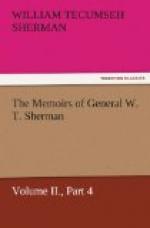The value of railways is also fully recognized in war quite as much as, if not more so than, in peace. The Atlanta campaign would simply have been impossible without the use of the railroads from Louisville to Nashville—one hundred and eighty-five miles—from Nashville to Chattanooga—one hundred and fifty-one miles—and from Chattanooga to Atlanta—one hundred and thirty-seven miles. Every mile of this “single track” was so delicate, that one man could in a minute have broken or moved a rail, but our trains usually carried along the tools and means to repair such a break. We had, however, to maintain strong guards and garrisons at each important bridge or trestle—the destruction of which would have necessitated time for rebuilding. For the protection of a bridge, one or two log block houses, two stories high, with a piece of ordnance and a small infantry guard, usually sufficed. The block-house had a small parapet and ditch about it, and the roof was made shot proof by earth piled on. These points could usually be reached only by a dash of the enemy’s cavalry, and many of these block houses successfully resisted serious attacks by both cavalry and artillery. The only block-house that was actually captured on the main was the one described near Allatoona. Our trains from Nashville forward were operated under military rules, and ran about ten miles an hour in gangs of four trains of ten cars each. Four such groups of trains daily made one hundred and sixty cars, of ten tons each, carrying sixteen hundred tons, which exceeded the absolute necessity of the army, and allowed for the accidents that were common and inevitable. But, as I have recorded, that single




